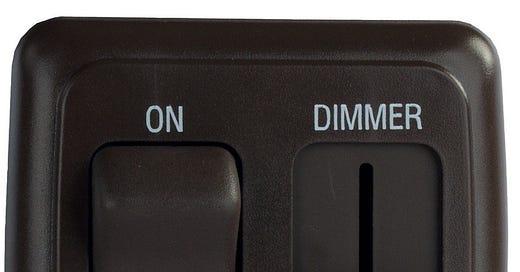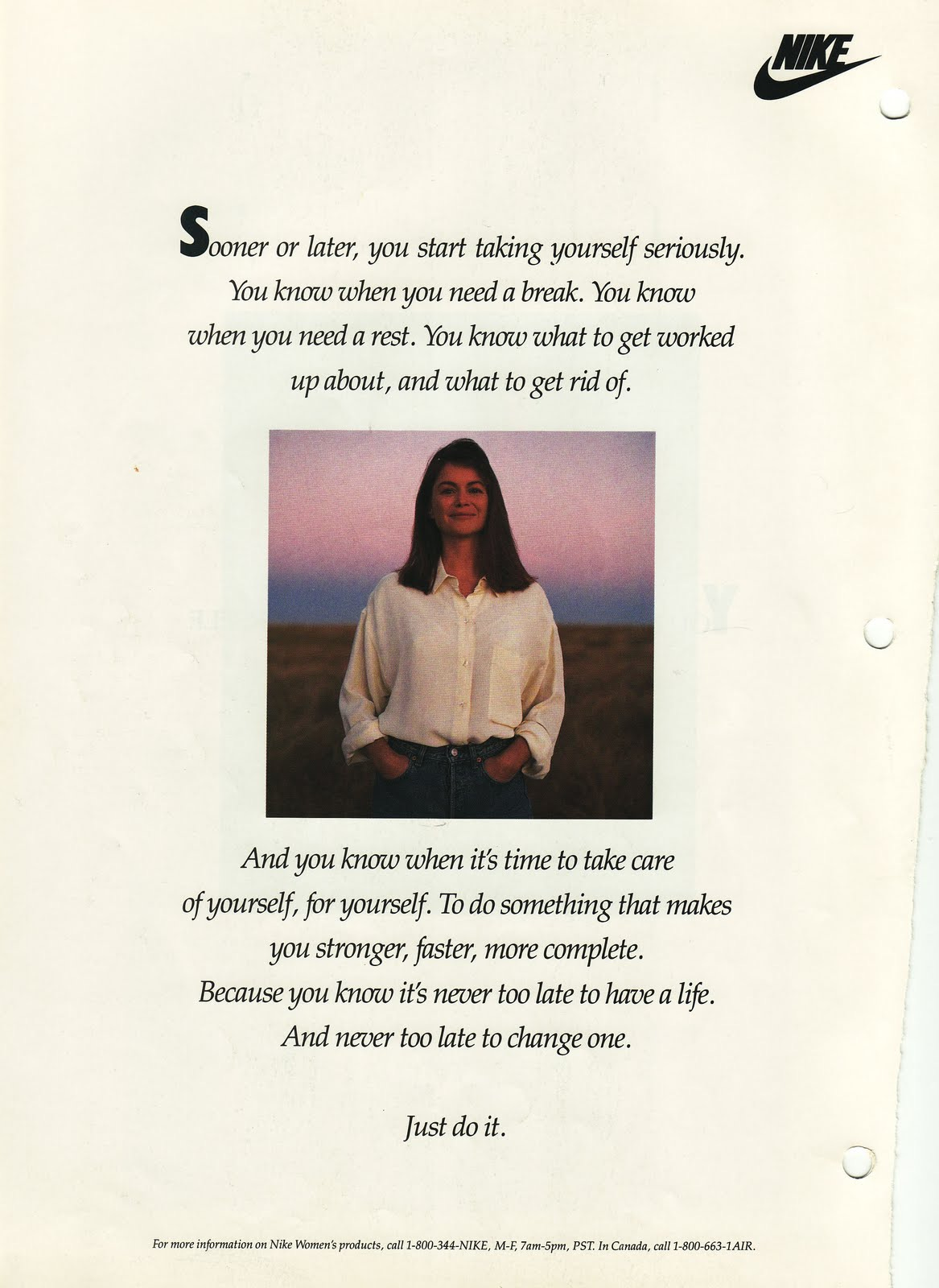5 min Read. It’s a long one – but sometimes you gotta #taketimetomaketime!
It was the late 80s or early 90s. I was a teenager.
Back in the day when magazine ads were enticing and used for scrapbooks or wall posters rather than recycling.
I cut out this 8-page Nike ad full of inspirational statements empowering girls to be all they wanted to be. At the time, I was a competitive gymnast training 20-25 hours a week, hoping to get somewhere big one day. "Just do it" resonated.
But the message was more nuanced than just pushing harder.
The ad took you on a journey. We got to walk in the shoes of the young girl shown below on Page 1 with a wish to become a "princess" (aka 'good girl') all the way through to a middle-age woman on Page 8 who knows when to "Just Do it" and when to "Let go."
This ad definitely made an impact on me at the time (I still have it in my childhood scrapbook!). But like many high performers who grew alongside Nike's brand, I got stuck on the flashy bottom line "Just do it" and missed the memo on how to balance that with "letting go." This led to many detours in my life but now I can proudly say I get it -- and I'm on a mission to share it with others so they do too.
The Presenting Challenge
Like I used to, many high performers I work with also find themselves stuck in the "Just Do It" mentality.
The reason? The "Just Do It" feeling is what drives them. It feels powerful. It makes them feel like they are awesomely "ON."
That's not the problem. It works.
But for some people being "ON" sometimes becomes more than that. It becomes a compulsion. An identity. A way of frantically avoiding the dreaded state of being "OFF."
This is not healthy.
I know because well...I've been there. It's also why many high performers show up in my -- and other psychologists' - offices.
What do I know now that I didn't know back then?
True excellence means being:
Able to access BOTH the ON and OFF buttons (sometimes at the same time!). The concepts of flow or "wu wei" (effortless action) come to mind here.
Flexible and adaptable enough to move along the spectrum from ON to OFF depending on the demands of the situation.
Grounded in awareness of what's needed to perform at one's best.
In control of "moving the dials" in terms of intensity, attention, and identity rather than being left to a binary choice of "ON" or "OFF."
Let me explain.
Beyond the Surface: What's Really Happening
For many high achievers, "being on" isn't just about productivity and performance outcomes — it's about a basic sense of worth and belonging. We learned early that achievement was the reliable way to receive approval, love, or acceptance.
The trap sets in when we internalize external expectations. Those rigid rules often come from others—parents, coaches, bosses, teachers—who taught us that our value depends on meeting certain standards of performance. We had to be the "best" athlete, daughter, son, student, performer to stay connected to important others.
For perfectionists and those with a high need for approval, this becomes especially toxic:
If I'm "ON," I'm GOOD
If I'm "OFF," I'm BAD (and therefore might be rejected)
And as a kiddo without a frontal lobe, this feels as bad as being shunned from the tribe and we fear for our survival. Like we'll be alone forever.
So, obviously we needed to find ways to prevent THAT from happening!
Some people develop the overcompensating strategy of trying to be "ON" all the time. Whether it’s overthinking, overdoing, overtraining, over-accommodating (i.e, people pleasing), the goal is to avoid being OFF. This is where perfectionism becomes entrenched - but so does the collateral damage of anxiety, eating disorders, shame.
The tricky thing is that setting high standards and striving for "ON" works. It can lead to impressive achievements and exhilarating highs (aka dopamine hits!) in the short term.
But eventually, this pendulum swings to feeling "OFF" because the "ON" position is so precarious and unsustainable. As much as I have tried to find a way to hack the system, we just can't avoid mistakes and failures in life!
Some people then get stuck in the "OFF" position. Sometimes this looks like procrastination, avoidance, withdrawing and feeling a bit lost in terms of where you're going in life. But by the time people reach me, it's more often the case that a major depressive episode or complete nervous system shut down has set in.
Because these people don't see a way out of being "OFF" without getting back to being fully "ON" again, they feel helpless and figure that not trying is safer than trying and failing. So they give up, numb out, and may even consider suicide.
The Breakthrough Tool
So what's the alternative? I call it "The Dimmer Switch."
Most of us operate with an ON/OFF toggle, but a dimmer allows for infinite gradations.
As I see it, this Dimmer Switch operates in three dimensions:
1. Intensity
With an ON/OFF Switch: From maximum exertion to complete shutdown. No middle ground.
With a Dimmer Switch: You can give 100% of whatever you've got available that day. If you're sick, tired, or dealing with life stressors, you can still control your effort within realistic limits. You can strategically choose your intensity based on what each situation actually needs—like an athlete managing energy through a competition or an executive who knows how to plan their schedule around which meetings require their highest energy.
2. Attention
With an ON/OFF Switch: Your mind is stuck focusing on creating the "ON" feeling. Or it's focusing too much on the fact that you're NOT (i.e., feeling "OFF"). You're caught in a constant need to optimize, do more, and be more—always seeking the perfect strategy or solution. You obsess over outcomes, replay mistakes, and worry about future challenges. You compare. You focus on what others think of you. Even during downtime, your thoughts are consumed with work, planning, or problem-solving. You resist anything that makes you feel "OFF" and so you miss important things and can't learn from those unpleasant feelings.
With a Dimmer Switch: You can direct your attention where it's most effective (as Alex Auerbach says, to “What’s Important Now” or W.I.N.) while still holding the outcomes and goals lightly in mind. You recognize when less thinking is actually more productive. You focus on what's working and do more of it and consciously focus on mistakes as a way of learning rather than beating yourself up. You recognize when mental effort becomes diminishing returns and adjust accordingly. You can be mentally engaged without being mentally exhausted.
3. Identity
With an ON/OFF Switch: Your entire worth as a person is fused with your performance. You believe "I am what I achieve." Making mistakes means you are a complete failure. Being a little "OFF" feels like you've lost total control. Rest doesn't feel like a strategic choice - it feels like surrendering who you are. Your core sense of self fluctuates wildly based on recent results. You are constantly fearing a "fall from grace" in other people's eyes when you're not fully "ON." You start to disconnect from yourself and your values, including the "why" behind your mission.
With a Dimmer Switch: You recognize that what you do is only one aspect of who you are. You can maintain alignment with your deeper values regardless of performance outcomes. You can take pride in your achievements without being defined by them. You define yourself by both the ups and the downs. You realize that asking for help or needing support doesn’t make you weak. You thrive by embracing both your strengths and weaknesses. You know you don't have to excel at everything to excel in what matters most. You let go of what doesn't matter. Your sense of intrinsic worth remains stable even when performance varies. YOU control the narrative of who you are - like the woman in the Nike Ad -- who has a sense of who she is and a purpose beyond the ON and OFF states, the successes and failures.
Summary: The Science of Sustainable Excellence
The research is clear: psychological flexibility—not rigid striving or perfectionism—is what allows high performers to thrive over the long term.
Moving from an ON/OFF switch to a Dimmer Switch puts us back in the driver's seat. We choose the intensity, the focus, and how we define ourselves.
When you master the Dimmer Switch across all dimensions, you develop what performance psychologists call "psychological agility"—the ability to respond effectively to changing conditions rather than reacting based on rigid, external rules. It allows you to manage the uncontrollables without being flipped to OFF when they arise.
Excellence is about perfecting the process, not the person.
Your Practice Until Next Time
1. A - Awareness:
Set a random reminder three times daily. When it goes off, note where your physical, mental, and identity dimmers are set (1-10). Ask yourself: Are you trying too hard for what it's worth? Is your mental focus where it needs to be? Does this task require your full identity investment? Just building awareness of your current settings is the essential first step.
2. R - Reflection:
Explore deeper: Whose voice do you hear when you judge yourself for dialing down? What experiences taught you that not being "on" all the time was unacceptable? When did you learn that your worth depends on your performance? These insights help loosen the grip of internalized expectations and reveal patterns worth changing. Using a therapist to help unpack and challenge these core beliefs is helpful if you get stuck here.
3. E - Experimentation:
Choose one task this week where you typically operate at maximum intensity, or where you tend to get stuck in "ON/OFF" thinking. Intentionally dial down your effort by 10-20%—not to underperform, but to discover if less might actually be more. Aim to show up "less than perfect" on purpose. Notice: Does performance actually suffer? Or do you find unexpected benefits in terms of ease, energy, power, efficiency, creativity, or enjoyment? This small experiment often reveals how tightly we're gripping our "on" state without necessity.
Parting Reflection
Excellence isn't about lowering standards—it's about holding the goal of being "ON" lightly, knowing that you can't (and don't need to) stay there to be okay. It's about working smarter, not always harder. Knowing when to "just do it" and when to "let go," while also developing a stable sense of self that isn't defined by either state.
It's about having the wisdom, flexibility and power to adjust your Dimmer Switch to what you, and each moment, truly needs.
Don't take my word for it! Use A.R.E to find out that a Dimmer Switch approach is not only possible, but can lead to more sustainable performance outcomes and certainly less collateral damage to your mental health!
I hope you enjoyed reading this deep dive into one of the key reasons why high performers get stuck and struggle with their mental health. Next time, I promise to give you a SHORTER read with live case examples of the Dimmer Switch in action - including how you can help others to develop it!
Until then,
~Heather






